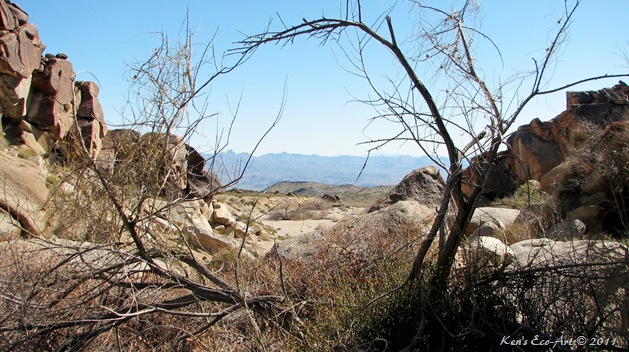 |
| I first visited Grapevine Canyon on 02/23/2010 with my wife Connie on a return trip from Laughlin Nevada. This shot, looking south, was taken from just a few hundred feet up into the canyon. |
Tuesday
Grapevine Canyon
Wednesday
Compass Barrel Cactus (Ferocactus cylindraceus)
 |
| (Fig. 01) |
Description: Barrel Cactus (Ferocactus cylindraceus), a.k.a. the Red Compass Barrel Cactus, is a large, round, barrel-shaped cactus with ribs (flutes) running from bottom to top. Barrel cactus start out short and wide (globular), then grow to about 5-ft tall and 16 inches in diameter. The plants are covered with relatively long, stout, flattened spines. The spines are erect and spreading, the longest are recurved, and they have some red color. Yellow flowers form a ring around the top of the stem. Barrels are generally uncommon cactus of rocky hillsides, but they can be locally common. Barrel cactus most often occur in rocky places and cliffs in the Upper Sonoran (Mojave Desert Scrub and Pinyon-Juniper Woodland) life zone, although they can be found on bajadas below cliff areas. One of the best places to see Barrel Cactus around Las Vegas is on Fossil Hill at Red Rock Canyon. View some more shots here [Barrel Cactus of Grapevine Canyon].
Area Description: You'll find the exit to amazing Grapevine Canyon just north of Laughlin, NV. It's a mile-and-a-half drive on a smooth, graded gravel road to the trailhead. Here you'll find a passageway that dates back centuries. As you walk up the easy, one-mile trail you will bear witness to the announcements of our continental forebears; petroglyphs carved into the rocky walls of the canyon mouth. These enigmatic looping, geometric and curvy lithic inscriptions are akin to the sacred frescoes found in cathedrals. During spring and summer, wild grapevines fill the canyon's stream bed. Small waterfalls can be found in wetter months, too. The rocky mountain peak above Grapevine Canyon is known as Spirit Mountain and is sacred, like the canyon, to the Yuman tribes of the lower Colorado River region.
Subscribe to:
Posts (Atom)
